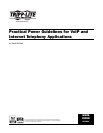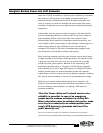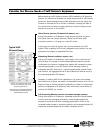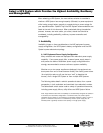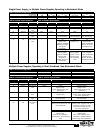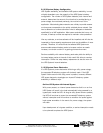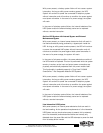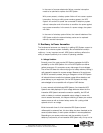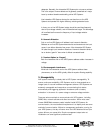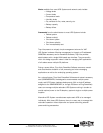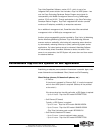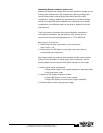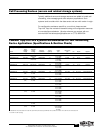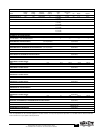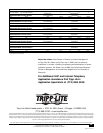
8
© 2008 TRIPP LITE. ALL RIGHTS RESERVED. THE POLICY OF TRIPP LITE IS ONE OF CONTINUOUS IMPROVEMENT.
SPECIFICATIONS ARE SUBJECT TO CHANGE WITHOUT NOTICE.
ALL TRADEMARKS ARE THE PROPERTY OF THEIR RESPECTIVE OWNERS.
In the event of a power electronics failure, a service interruption
needs to be planned to replace the UPS System.
With power present, a battery system failure will not cause a system
interruption. As long as utility power remains present, the UPS
System will continue to power the connected IP telephony system
without interruption and will continue to condition the power against
many power anomalies. In the event of a power outage, the system
will crash.
In the event of a battery system failure, the internal batteries of the
UPS System and/or the external battery packs can be replaced
without a service interruption.
2. Resiliency to Power Anomalies
The fundamental outcome one hopes for in adding UPS System support to
a network is to enhance system availability. But an additional concept—
resiliency—is very important as well. UPS System resiliency reflects the
ability to respond positively to a number of operating variables.
A. Voltage Variation
Currently, one of the most popular UPS System topologies for VoIP is
provided by on-line UPS Systems. An on-line UPS System can deliver
perfect power even if it encounters a very wide range of input voltages.
The on-line UPS does this without relying on its battery reserves, leaving it
well prepared to respond to a power outage. Because of its continuous
AC-DC-AC conversion process, during an outage an on-line UPS System
will also exhibit zero transfer time between power failure detection and
power delivery to your equipment. On-line UPS Systems are widely
acknowledged to be compatible with all types of VoIP devices.
In many networks with distributed UPS Systems, line-interactive UPS
Systems are widely deployed. If input voltage levels are below the line-
interactive UPS System's automatic correction capability, the UPS will
switch to battery to maintain acceptable output voltage. In areas with
chronic extreme brownouts, this frequent switching to battery can reduce
reserve power as well as shorten battery service life—putting critical
systems at risk in an outage.
While the transfer time of a line-interactive UPS System (several
milliseconds) is extremely fast, this short delay has been theorized as the
cause of packet losses, or even system shutdown in some applications.
Depending on your power environment and the sensitivity of your IP
telephony components, a line-interactive UPS System may or may not be



